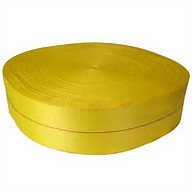- Local: (516) 346-4636
- Toll-Free: (800) 886-6060
- Fax: (516) 346-4366
- Email: kflynn@nationalwebbing.com
There are four main types of material used to make webbing. Each material has its unique priorities, which means that webbing should be chosen based on application and environment. Regardless of the fabric used, webbing is a durable material woven into flat strips of varying widths. Certain webbing functions better in outdoor environments where they are getting wet. UV rays are particularly bad for cotton webbing, which means if materials are left in direct sunlight for extended periods, you will want to use nylon or polypropylene. Out of the four popular material choices, two stand out: nylon and polyester.
 Both nylon and polyester are lightweight and robust. They are synthetic materials that share many of the same properties. They resist stretching, and they are straightforward to care for. Although there are many similarities, there are enough differences that make one better suited than another at certain times.
Both nylon and polyester are lightweight and robust. They are synthetic materials that share many of the same properties. They resist stretching, and they are straightforward to care for. Although there are many similarities, there are enough differences that make one better suited than another at certain times.
One of the best aspects of nylon is that it can go back to its normal state without damage after being stretched. On the other hand, however, nylon does not do well resisting mildew. Extensive exposure to the sun causes colors to fade and bleed. Therefore, nylon is not the best choice for outdoor and marine environments.
You can often find polyester webbing used within the transportation industry because it is effective as a ratchet strap and tie-down. Polyester benefits from having a low elongation property. Unlike nylon, polyester webbing works well outside because it naturally inhibits UV rays offering excellent protection from the sun. Lastly, polyester has high strength and excellent impact resistance.
Regardless of the material you use, you must get the right one for you. One material is better than another when working with a strict budget and unique application.